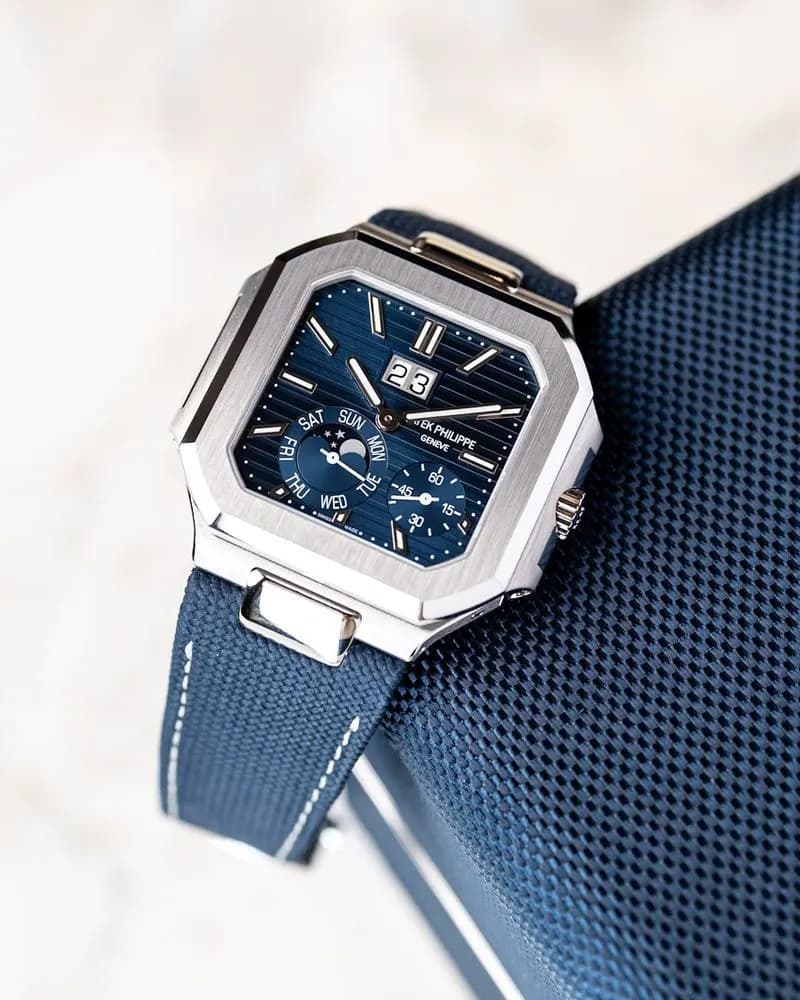From a technical point of view, this is a big step forward for the Manufacture because this new chronograph represents a real improvement compared to its mythical predecessor, the "4 Digits":
- Three different model references: 16520 (steel), 16523 (gold/steel) and 16528 (gold)
- Different case size, the diameter increases from 37.5 mm to 39.0 mm
- Rolex changes their movement supplier and introduces a brand new caliber, developed from a Zenith El Primero model, the 4030 movement. It is the brand's first chronograph to be classified as "perpetual". It is important to point out that Rolex has replaced more than half of the parts that go into this movement in order to improve its performance, something that some people tend to ignore. This is important because the 90's mark a turning point in the history of Rolex, which will break away from its role as an assembler to become a full-fledged manufacturer (which is what the brand undoubtedly is today).
We introduce in this article the dials and bezels from what we call Daytona "Zenith Early Generation"
The various dials
MK1 Dial (Mark 1)
The first version of the dial, known as the MK1, has a certain peculiarity which will later on become a "rarity" for collectors. For this new model reference, the brand wanted to mention all its characteristics on the dial, without forgetting the model's important names, and that represented a significant amount of text. Rolex decided to print everything on the dial (no less than six lines, including five at 12 o'clock and the sixth at the top of the hour counter at 6 o'clock):
| Line | Inscription | Explanation |
|---|
| 1 | ROLEX | The brand |
| 2 | OYSTER PERPETUAL | The automatic movement |
| 3 & 4 | SUPERLATIVE CHRONOMETER / OFFICIALLY CERTIFIED | Precision certification by the "Contrôle Officiel Suisse des Chronomètres (COSC) |
| 5 | COSMOGRAPH | New term created by Rolex that was first used in the 1950s for a watch with a moon phase and calendar function (ref. 6062), and later used for chronographs (6239 in 1963). |
| 6 | DAYTONA | Generic name used by the brand from 1965 on ref. 6239 in order to market this model with motor racing. |

Image of black MK1 "Floating Dial"
The first version of the (MK1) dial is distinguished by a space after "Superlative Chronometer Officially Certified", most probably for the sake of legibility. This space will earn it the name of the "Floating Dial". But what makes it a collector's item is that this dial will only be produced for a little over a year. It is understandable why some "Floating" models in the best possible conditions (full set, impeccable condition,...) are priced higher than the sometimes more commonplace 4 digit Daytona (with a larger production volume).
Although the model reference 16520 was introduced in 1988 during Baselworld, this does not mean that production started that same year. In fact, Rolex started to produce this model at the end of 1987. The last model references 6265 and 6263 were also produced in 1987.
The 16520 reference is no longer produced with a 7-digit serial number since the manufacture had already produced more than 10 million watches, but with a 6-digit number preceded by the letter "R" with the digits starting with 0. The first "R" series began in 1987 and continued until the end of 1988.
Theoretically, during those two years, this MK1 dial will be used on this watch. I say "theoretically" because there are "floating" dials on watches with references that have the letter "L", which began in 1989... Complicated? Not really... I'll come back to this later on.

Daytona 16520 « Floating Dial » black & white models
MK2 Dials (Mark 2)
The dial changed on the "L" series, in 1989. The new dial remains the same but Rolex removed the "OFFICIALLY CERTIFIED" line. The top of the dial now displays only four lines, which will earn it the name "4 Lines". This dial only appeared one year and was also replaced in 1990 by a "5 lines", but without a space making it "non-floating".
As you can see, these two dials quickly became very rare among collectors, considering that this reference was produced up until 2000 in a version with 5 consecutive lines and without a space.

Daytona 16520 « 4 Lines » Dials white and black
Two collectible dials
In the late 1990s, many brand specialists and experts classified the two dials as follows:
| Floating | R Series (1987-1988) |
| 4 Lignes | L Series (1989) |
Since the market for collector's watches is growing, we uncovered many 16520 "floating" watches dating from the beginning of 1989, the "L" series. Here's a little explanation. We are not aware of a ruling from the manufacture that a dial must change from one year to the next. The ROLEX manufacture almost always produced more spare parts for its after sales service. The totality of the "floating" dials remaining, produced by Singer, were used before delivering (for what use?) the new "4 lines" dials produced by the same company.
We have never observed a "4 lines" dial on an "E series".
A priceless dial: the "Porcelain" Dial
There is no real difference in terms of rarity between the "floating" and the "4 lines". There is however a version of the "floating" dial called "porcelain" only on white dials. This dial was called "porcelain" because it quite simply resembles porcelain. Technically, this dial is not made of porcelain but lacquered. The technique used is a lacquer overlay with the last layer polished. This is less expensive than enameling and gives it a very similar look. This white dial version is by far the rarest of all. It is recognized by the quality of its finish, depth, and shine.

Image of a "Porcelain" dial on ref. 16520 ©Sotheby's
Reader's note: all this information is based off observations, and Rolex never communicated any information on this subject. It is worth considering that the manufacture produces nearly a million watches each year and can be seen as "industrial". It was not uncommon at the time for leftover stocks of dials and bezels to be used for production purposes. Unfortunately, in the early 2000's, some dealers took the liberty of changing this in order to "match" the original texts, as was the case for the case back references on the 4-digit Daytona watches, which many collectors swapped in order to have a case back reference corresponding to the watch reference (6238-6239-6262-6241-6264-6265-6263).
I can testify that I have seen many watches acquired in the 70's by a first owner, which were never sent back to Rolex for servicing and were fitted with a case back that does not match the model reference of the watch.
Different bezels
There are two different bezels for these three different years of production and the rule is relatively identical to that of the dials.
MK1 Bezel (Mark 1)
The MK1 bezel is engraved with a tachymetric scale graduated up to 200 units per hour (200-180-160, that goes up to 50). This bezel is most commonly found on the "R" series, but can also, like the MK1 dial, be found on the very first "L" series.

Graduation 50-200 MK1
MK2 Bezel (Mark 2)
The MK2 bezel is engraved with a tachymetric scale graduated up to 400 units per hour (400-300-250-225, that goes up to 60). This bezel is theoretically found on the "L" series.

Graduation 400-60 MK2
Specs of 16520 "Early Generation"
| Year | Serial Number | Cadran | Color | Bezel | Bracelet | Production |
|---|
| 1987 | End of year production from R000001 | MK1 5 Lines "Floating" | Black dials are the rarest | Graduation 200 units | Model 78360 entirely brushed | Small production, rare watches |
| 1988 | Production sur une année jusqu’au n° R598200 | MK1 5 Lines "Floating" | Black dials are the rarest | Graduation 200 units | Model 78360 entirely brushed | Small production, rare watches |
| 1989 | Production sur une année jusqu’au n° L980000 | MK2 4 lignes | Black dials are the rarest | Graduation 400 unités avec « 225 » | Model 78360 entirely brushed | Small production, rare watches |
Some future perspectives for ref. 16520 (MK1 & MK2)
In this article, you have seen that the majority of the watches equipped with a MK1 dial were produced between the end of 1987 and the end of 1988 and are equipped with a bezel graduated to 200 units. The majority of watches with MK2 dials were produced during 1989 and are equipped with a bezel graduated to 400 units and display the number "225" which will later disappear. It is probable that a MK1 version was distributed at the beginning of 1989, just as it is possible that a MK2 version was distributed at the very beginning of 1990. It is also possible to find a MK2 version, in the very beginning of 1989, equipped with a MK1 bezel. This is not an exact science but a simple observation, one that takes into account the way Rolex was operating and managing their production at that time.
I hope you enjoyed reading this article and that you can see things clearer now. Contact us for an additional information.
Rolex Daytona 16520 "Floating Dial" available at 41Watch
Get it

Rolex Daytona 16520 “4 Liner” available at 41 Watch
Get it




























